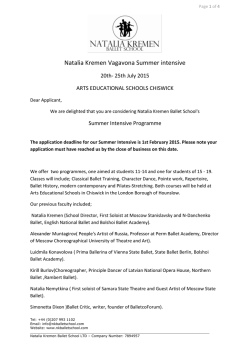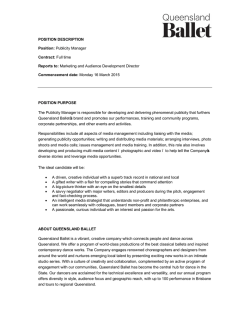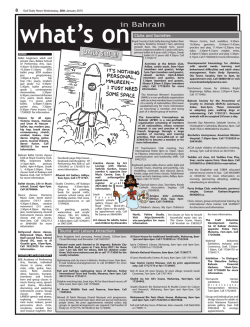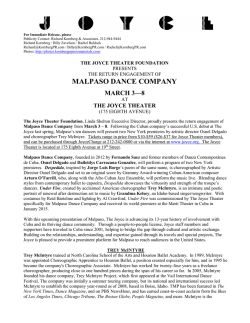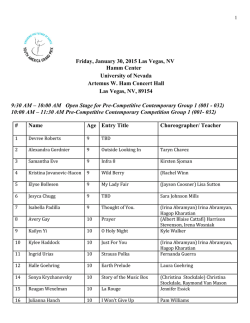
Read Playbill - Three Stages at Folsom Lake College
Russian National Ballet Theatre
Tuesday, February 3, 2015; 7:30 pm – Giselle
Wednesday, February 4, 2015; 7:30 pm – Chopiniana; Romeo and Juliet
Thursday, February 5, 2015; 7:30 pm – Don Quixote
RUSSIAN NATIONAL BALLET THEATRE
Artistic Director: Elena Radchenko
The Russian National Ballet Theatre was founded in Moscow during the transitional period of Perestroika in the late 1980s,
when many of the great dancers and choreographers of the Soviet Union's ballet institutions were exercising their new-found
creative freedom by starting new, vibrant companies dedicated not only to the timeless tradition of classical Russian Ballet but
to invigorate this tradition as the Russians began to accept new developments in the dance from around the world.
The company, then titled the Soviet National Ballet, was founded by and incorporated graduates from the great Russian
choreographic schools of Moscow, St. Petersburg and Perm. The principal dancers of the company came from the upper ranks
of the great ballet companies and academies of Russia, and the companies of Riga, Kiev and even Warsaw. Today, the Russian
National Ballet Theatre is its own institution, with over 50 dancers of singular instruction and vast experience, many of whom
have been with the company since its inception.
In 1994, the legendary Bolshoi principal dancer Elena Radchenko was selected by Presidential decree to assume the first
permanent artistic directorship of the company. Ms. Radchenko is the founder of the Russian National Ballet Theatre, and
she has focused the Company on upholding the grand national tradition of the major Russian ballet works and developing
new talents throughout Russia, with a repertory of virtually all of the great full works of Petipa: Don Quixote, La Bayadere,
The Sleeping Beauty, Swan Lake, Raymonda, Paquita, Coppelia and La Sylphide, as well as productions of, among others, The
Nutcracker, Sylvia, and La Fille Mal Gardee.
GISELLE
Full length Ballet in Two Acts
Music: Adolphe Adam
Libretto: Jules-Henri Vernoy de Saint-Georges and
Théophile Gautier
Choreography: Marius Petipa
Sets: Lev Solodovnikov
Costumes: E. Radchenko
ACT I
A Rhineland Village
–Intermission–
Photography by Larissa Pedenehuk
ACT II
Giselle’s Grave
Act I
A Rhineland Village
Giselle, a peasant girl, has fallen in love with Count Albrécht,
who has led her to believe that he is a villager named Loys.
Her superstitious mother, Berthe, hoping that Giselle will
marry the forester Hilarion, warns her against Loys, to
whom she has taken an instinctive dislike.
In order to discourage Giselle's love for 'Loys', Berthe further
recounts the legend of the Wilis -ghosts of young girls who
have been jilted and die before their wedding day: to avenge
themselves, they dance to death any man who crosses their
paths between midnight and dawn. But Giselle disregards
her mother and joins, with her beloved, in the celebrations
www.harriscenter.net SPRING 2015 PROGRAM GUIDE A 35
Russian National Ballet Theatre – Giselle
that mark the end of the grape harvest, when she is crowned
Queen of the Vintage.
Wilfred, Albrécht's squire, secretly warns him that a hunting
party is approaching, led by the Duke of Courland and the
Countes Bathilde (Albrécht's future bride), who are staying at
Albrécht's castle for the betrothal ceremony. Albrécht hides,
but Hilarion has witnessed this meeting and decides to break
in to 'Loy's' cottage to discover the secret of his identity. The
hunting party arrives. Giselle dances for the nobles and
when she tells Bathilde that she too is engaged, the Countess
gives her a necklace. Bathilde, tired from hunting, asks to
rest in Berthe's cottage, but the Duke decides to continue the
hunt and orders a hunting horn to be left by the cottage door
so that he and the rest of the party may be recalled when
Berthe is ready to rejoin them. Hilarion now reappears from
"Loys's cottage. He has found Albrécht's sword and when
he compares it with the hunting horn, he sees that they bear
the same crest; this gives him the evidence for which he
has been looking. Not realizing that the hunt is still nearby,
Albrécht returns. Hilarion interrupts the dancing and reveals
the truth about 'Loys'. He sounds the horn, the hunting party
returns and Bathilde, coming out of the cottage, claims
Albrécht as her fiancé. The shock is too much for Giselle and
she loses her reason. In her madness she relives her love for
'Loys' and, seizing his sword, she kills herself.
–Intermission–
ACT II
Giselle's Grave in the Forest
Hilarion keeps vigil by Giselle's grave, which lies deep in
the forest in unconsecrated ground. It is midnight, the time
when the Wilis materialize. Hilarion flees in terror when
confronted by these apparitions. Myrthe, their queen, now
arrives from the marshes and summons her Wilis. She
draws Giselle from her grave to be initiated into their rites.
The Wilis disperse as Albrécht approaches, searching for
Giselle's grave. He lays flowers at the cross and when
Giselle's spirit appears to him, he follows it into the forest.
Hilarion, pursued by the Wilis, returns and is forced into an
endless dance. Exhausted, he is driven into the lake, where
he drowns. The Wilis now seek out Albrécht and when
Myrthe commands him to dance, Giselle urges him to the
safety of the cross, but he is powerless when Myrthe orders
Giselle to entice him away by dancing with him. Giselle tries
to sustain him, but as the night wears on he becomes weaker
and weaker. Just as he is about to die, dawn breaks. Daylight
destroys the Wilis' power and the ghostly dancers fade away;
Giselle, whose love has transcended death, returns to her
grave, her spirits freed from the power of the Wilis,
leaving Albrécht sorrowing and alone.
Giselle: The Music and Its Creator
Adolphe Adam was born in 1803 in Paris. His father, Louis
Adam, came from Alsace and was a well-known pianist,
professor at the Conservatoire and author of a best-selling
piano method. Surprisingly, he was opposed to any musical
36 SPRING 2015 PROGRAM GUIDE A www.harriscenter.ne
education for his son, but eventually allowed him to enter the
Conservatoire. After a slow start Adolphe became a pupil of
Boieldeu, composer of La Dame Blanche, and began to write
with remarkable facility. At 22 he received the Second Prix
de Rome and in 1830 his opera Danilova was presented at
the Opéra Comique. During the next 18 months he composed
four operas, all staged in Paris. He married the sister of
Pierre Laporte, director of the Covent Garden Theatre. This
connection brought him to London in 1832 for the premieres
of his two English comic operas, The First Campaign and
The Dark Diamond, and a year later he returned with a ballet
score, Faust, for the King's Theatre.
More than 50 stage works followed, many of them
enormously successful, including the comic operas Le Chalet,
Le Postillon de Longjumeau, La Poupée de Nuremberg, Si j'étais
Roi and the ballets Le Diable á Quatre, La jolie fille de Gand,
La Fille du Danube, Le Corsaire and of course, Giselle, his
acknowledged masterpiece. Adam became one of the most
popular composers of his time, as well-known in Berlin and
St. Petersburg as in Paris and London. His last stage work
was a delightful one-act operetta, Les Pantins de Violette,
given its premiere on April 29, 1856 at Offenbach's BouffesParisiens. Adam died in his sleep four nights later.
The apparent simplicity of Adam's music is deceptive
because the piano editions of his operas and ballets,
published for sale to a mass market of amateurs, required
such basic presentation. He was in fact expert at creating
instant theatrical effects with short melodic motifs tailormade for character or situation and with unexpected
harmonic progressions to control the audience's emotional
tension. Like his compatriots Auber and Hérold, similarly
involved in opéra comique, he benefited from the influence of
Rossini and Donizetti, and if all three were inevitably under
the shadow of Meyerbeer when attempting grand opera, they
were nonetheless totally successful in providing high-class
entertainment for most of Europe for well over half a century.
Adam's accounts of composing Giselle vary: in one place he
recalls having written the score in eight days, elsewhere he
mentions three weeks. The historian Ivor Guest has examined
a manuscript score which records dates of completion
for separate sections, ranging from April 11, 1841 to the
last entry on June 8. Adam may well have been referring
to first sketches. At any rate he seems to have enjoyed
the collaboration between himself, the rising young star
Carlotta Grisi, and her choreographer-mentor Jules Perrot: 'I
composed the music in high spirits. I was in a hurry and that
always fires my imagination. I was very friendly with Perrot
and Carlotta, and the piece evolved, as it were, in my drawing
room.'
Although Giselle was not the first ballet to adopt an
elementary Leitmotif procedure, it is certainly the earliest
that is still in the repertory. The first act contains more
examples of this device than the second, because the first
lends itself more to the mime scenes necessary to establish
the plot in the earlier part of the ballet than it does to set
dance pieces. One obvious example is the short, stabbing,
Russian National Ballet Theatre – Giselle
unharmonized motif associated with Hilarion, another is
the repeated and flexible use of the love theme for Giselle
and Albrécht, recalled towards the end of the first act in
fragmented form and chromatically raised pitch layers. The
set dance sections are composed in the form of their aria and
ensemble counterparts in operas of the time: quadrilles,
waltzes, polaccas, galops, nocturnes or tarantellas. Adam
uses these forms with a certain freedom and juxtaposes
them effectively.
Although Giselle was not the first ballet to adopt an
elementary Leitmotif procedure, it is certainly the earliest
that is still in the repertory. The first act contains more
examples of this device than the second, because the first
lends itself more to the mime scenes necessary to establish
the plot in the earlier part of the ballet than it does to set
dance pieces. One obvious example is the short, stabbing,
unharmonized motif associated with Hilarion, another is
the repeated and flexible use of the love theme for Giselle
and Albrécht, recalled towards the end of the first act in
fragmented form and chromatically raised pitch layers. The
set dance sections are composed in the form of their aria
and ensemble counterparts in operas of the time: quadrilles,
waltzes, polaccas, galops, nocturnes or tarantellas. Adam
uses these forms with a certain freedom and juxtaposes
them effectively.
The enormous popularity of Giselle has had a curious effect
on its music. Since the mid 19th century, the numerous
productions in different countries have brought about many
changes of detail in choreography and scenario. It was
not normal practice to import orchestral material for new
productions of ballets of that period. The choreographer
would rehearse the dancers to the sound of one violin,
sometimes two, playing from a violin conductor part,
prepared from the original score. An orchestration would
then be ordered from a local musician, inevitably reflecting
whatever changes had been made. That is why the great
centers of ballet culture have inherited variants of the
original music and its instrumentation. Adam's orchestral
score was never published and the foregoing comments may
perhaps explain why there had been no urgent search for it.
Photography by Larissa Pedenehuk
Giselle was first seen in Moscow in 1843, just two years after
its creation in Paris, and a year after it was staged in St.
Petersburg. The ballet's history in Russia since that time has
shown a continuous sequence of performances, with Jules
Perrot - one of the great originators of the choreography providing a basic text which has been illuminated by the care
and genius of generations of ballerinas and producers. When
Giselle was forgotten everywhere else in Europe - it was
dropped from the Paris Opera repertory in 1868 - Russian
dancers and ballet-masters preserved and honored it. The
Moscow Festival Ballet's production maintains the Russian
tradition of scrupulous production and loving concern for this
gem of the Romantic ballet.
www.harriscenter.net SPRING 2015 PROGRAM GUIDE A 37
Russian National Ballet Theatre
Chopiniana; Romeo and Juliet
Wednesday, February 4, 2015; 7:30 pm
CHOPINIANA
Grand pas.
Music by Frederic Chopin
(Suite of piano pieces orchestrated by Alexander Glazunov)
Choreography by Mikhail Fokine
Sets and costumes by Elena and Sergei Radchenko
Premiere: February 23, 1907 Marinski Theatre, St. Petersburg
PROGRAM NOTES
Chopiniana grew out of Chopin’s "Seventh Waltz" and had its
premiere on February 23, 1907. The favorite oeuvre of its
creator, Mikhail Fokine, this work has now become standard
repertoire for many of the world’s leading theatres.
Chopiniana does not have a traditional plot. The curtain
opens to reveal a picturesque group of ballerinas, frozen in
anticipation, the embodiment of the Young Man’s dream. The
women rise like a romantic vision, circle around the Young
Man, spread out like a light fog and then freeze again in their
original poses.
This ballet is in one regard, a timeless poetic example of
stylization, and in another, a work set distinctly in its own
period. Fokine incorporated the cultural experiences of the
past and the blossoming ideas of the present, thus saturating
the work with universal significance. It is not the characters
in the ballet that develop, but rather the themes, moods, and
feelings.
-Intermission-
ROMEO AND JULIET
AFTER WILLIAM SHAKESPEARE’S TRAGEDY
Full-length Ballet
Music by Pyotr Ilyich Tchaikowski
Original choreography by Marius Petipa
Restaged by Elena Radchenko
Sets and costumes by Elena and Sergey Radchenko
Libretto by Elena and Sergei Radchenko
PROGRAM NOTES
Scene 1
The Capulets are hosting a magnificent celebration. By
their house a crowd of guests is dancing in the square. The
Montagues, who are the Capulets enemies and rivals, are
naturally not invited.
There are Mercutio and Benvolio with friends. They try to
persuade their friend Romeo, Lord Montague’s son, to put on
a mask with them and sneak into the feast. Romeo agrees.
In the course of the merriment and dancing, Romeo meets
Juliet, who unmasks him. They instantly fall in love with each
other.
38 SPRING 2015 PROGRAM GUIDE A www.harriscenter.net
Lady Capulet’s nephew, Tybalt, is a desperate rake and
squabbler. On seeing the strangers at the celebration, he
starts a fight with Mercutio. However Mercutio makes fun
of Tybalt and cheers everybody up. Mercutio, Romeo’s best
friend, gets villainously killed by Tybalt in a brawl. Romeo
confronts and accidently slays Tybalt, who dies before the
Capulets’ eyes.
They are in grief and ask for revenge. Romeo runs away. He
hurries to a rendezvous with his beloved Juliet. Risking his
life, Romeo gets into Juliet’s bedroom.
Scene 2
The loving couple meet. They carry on a dialogue. They vow
fidelity until death parts them and become a husband and a
wife. Suddenly a nurse appears and warns that Juliet’s
parents and Paris are coming. They have chosen him as a
rich fiancée for their daughter. The parents have a stern
conversation with Juliet, who doesn’t want to marry Paris.
The father is outraged. He tells Juliet that she will marry
Paris tomorrow. The three of them leave the bedroom.
Juliet is stricken with the news. She asks Friar Laurence
to give her a hypnotic drug so that she looks dead and the
wedding with Paris can be cancelled. Juliet takes the drug to
fall asleep, but Romeo does not know anything about it.
Learning about Juliet’s death, he runs into her bedroom to
die next to her. Romeo sees Juliet and believes that she is
dead. He cannot imagine life without her so he has some
poison prepared and he takes it. Before his death Romeo has
visions and then everything plunges into darkness. Having
woken up, Juliet sees her dead Romeo. He hasn’t left even a
drop of poison for her. Juliet then stabs herself with Romeo’s
dagger hoping to see her beloved and unite in the next world.
“For never was a story of more woe than this of Juliet and her
Romeo”
Russian National Ballet Theatre – Don Quixote
Thursday, February 5, 2015; 7:30 pm
DON QUIXOTE
Full-length ballet in Three Acts
Music: Leon Minkus
Libretto: Marius Petipa
Choreography: Marius Petipa
Sets: Lev Solodovnikov
Costumes: Lev Solodovnikov
Lighting: Marina Borodina
Prologue
Don Quixote's Study
Act I
The Square in Barcelona
Act II
A Gypsy Encampment
Act III
Scene 1: A Forest
Scene 2: Night in a Village
protect Kitri/Dulcinea—he destroys the marionette theatre
and then charges against some windmills on the distant
horizon, which he takes for giants. Don Quixote falls to the
ground, where he remains unconscious.
–Intermission–
Act III
Scene 1: A Forest
Act III
Scene 3: A Tavern
Scene 4: The Palace
In a dream Dulcinea appears to her noble "knight" as queen
of the wood nymphs, who praises him for his courage and his
deeds and crowns him with laurel.
Prologue
Don Quixote's Study
Scene 2: Night in a Village
In his library the old nobleman Don Quixote de la Mancha sits
over his books, which tell him of distant times of knighthood.
Soon he believes himself called to knightly deeds: he
appoints his servant Sancha Panza his squire and sails
forth into the world to seek adventures in the service of the
beautiful Dulcinea, whom he has glimpsed in a vision.
Act I
The Square in Barcelona
On a market-place Don Quixote and Sancho Panza mingle
in the colorful bustle of the people. Kitri, daughter of the
innkeeper Lorenzo, and her sweetheart the barber Basilio
are among them. Their lovers' tryst is suddenly disturbed
by the entry of Kitri's father. He puts forward the old, rich
Camacho as the bridegroom he has chosen for his daughter.
In vain, Kitri and Basilio swear their love. Lorenzo is
adamant. Don Quixote, who believes he recognizes in Kitri his
Dulcinea, intervenes and helps the lovers to flee.
Comacho wakes Don Quixote from his dream and they both
go to the Tavern.
–Intermission–
Act III
Scene 3: A Tavern
Meanwhile, Lorenzo and Camacho have succeeded in
catching the fugitive Kitri again. She is now to be dragged
to the altar by force and married to the old man. Basilio is
in such despair over this that he is about to do away with
himself. However in the nick of time Don Quixote and Sancho
Panza appear, and everything turns out well—Kitri can marry
her Basilio.
Scene 4: The Palace
Act II
A Gypsy Encampment
It is fiesta time. Don Quixote watches the dancing. The scene
changes to the Palace. Kitri and Basilio with Don Quixote and
the rest celebrate their wedding in a Grand Pas de Deux. Don
Quixote realizes that he has not yet found his Dulcinea and
with Sancho, sets off for more adventures.
Kitri (who has disguised herself as a young man) and Basilio
have found refuge with a band of gypsies. Don Quixote and
Sancho Panza also appear on the scene, and in their honor
the gypsies put on a puppet -show. Don Quixote, however,
takes the play in bitter earnest and believes himself suddenly
menaced on all sides by evil powers, against whom he must
The resounding success of Don Quixote may substantially
have contributed, after Cesare Pugni's death (in January
1870) to Minkus being appointed his successor as first
Imperial ballet composer of the Marinsky Theatre in St.
Petersburg. After a new version of Don Quixote, which was
given its premiere on November 9, 1871, in 1872 he
www.harriscenter.net SPRING 2015 PROGRAM GUIDE A 39
Russian National Ballet Theatre – Don Quixote
composed, as one of his first new tasks, the ballet music
to the opera Mlada, which the theatre director Stephan
Gedeonov had commissioned as a joint composition from
Alexander Borodin, Cesar Cui, Modest Mussorgsky and
Nikolai Rimsky-Korsakov. The project was, however, never
completed, so that Minkus revised his material in 1879 for an
independent story ballet. Otherwise, in the following seasons
one ballet after another by Minkus was performed in the
Marinsky Theatre, all with Petipa's choreography: among
others, in 1872 Camargo, 1875 Les Brigands (in various
sources erroneously labeled as a collaboration with Delibes);
in 1876 Son v letnyinyi noch ("A Midsummer Night's Dream",
using Felix Mendelssohn- Bartholdy's incidental music); 1877
Bayaderka ("La Bayadere"); in 1878 Roksana; 1879 Frizak
and Snegurochka ("The Snow Maiden," after the play of that
name by Alexander Ostrovsky, for the first performance of
which in 1873 Tchaikovsky had composed the incidental
music, and which Rimsky-Korsakov took as the basis for an
opera in 1881); 1881 Paquita (as a new version of the ballet
of the same name by Edouard Delevez and Joseph Mazilier,
along with Soraya, ili Mavritanka v Ispanii ("The Moorish Girl
in Spain"); 1882 Noch i dyei ("Night and Day"); 1886 L'Offrande
a l'amour. And even after Minkus had retired from his official
posts in 1891 and returned to Vienna, he remained one
of the most popular and most played ballet composers of
St. Petersburg. Thus in July 1897, on occasion of the State
visit of Kaiser Wilhelm II to Tsar Nikolai, Petipa mounted in
Peterhof a pasticcio, Les Noces de Thetis et Pelee, which he
had arranged from an earlier ballet by Minkus and some
musical numbers by Delibes.
That despite this multitude of works and lasting successes
Leon Minkus fell so completely into oblivion essentially
has to do with function of ballet composition and the way in
which it is handled. "While in Russian opera from the time of
[Catterino] Cavos and [Alexei] Verstovsky the composer was
specially named as author, in the ballet in the 60s and later,
the ballet-master was considered the author, designed the
choreographic mise-en-scene, and he first commissioned a
composer who had to follow all his specifications -- from the
number of musical movements and their character to the
concrete tempi and metres, according to the type of dance.
The ballet -master had the right to insert new numbers
with music by other composers and generally to make
any alteration that seemed necessary, without asking the
composer's consent. Moreover, the composer was creatively
hemmed in by a plethora of rules that laid down how he had
to write ballet variations, duets, ensembles and character
and action dances. These rules were at that time considered
not only almost immutable, according to the laws of ballet
aesthetic, but were also fixed in the theatre contracts (E.M
Levashyova, quoted in Dorothea Redepenning: Geschichte
der russischen und sowjetiechen Musik, volume 1, p. 350:
Laaber 1994).
One of the first composers to revolt against this practice
was Pyotr Ilyich Tchaikovsky-after he himself had come to
feel its consequences, as George Balanchine related in his
interview with Solomon Volkov: "Anna Sobeschanskaya, a
prima in the Bolshoi Ballet in Tchaikovsky's day, danced in
the mediocre Moscow production of Swan Lake. In order to
40 SPRING 2015 PROGRAM GUIDE A www.harriscenter.net
liven up her benefit performance Sobeshchanskaya asked
Pepita to create a pas de deux for her, and she inserted
it in the third act of Swan Lake. She wasn't worried that
Petipa had done the pas de deux to music by Minkus!
Learning this, Tchaikovsky protested, "Ballet may be
good or bad, but I alone bear the responsibility for its
music." Tchaikovsky offered to write a new pas de deux
for the ballerina, but she did not wish to change Petipa's
choreography. So, taking Minkus's music Tchaikovsky
wrote his own pas de deux which fitted-measure for
measure the dance Sobeshchanskaya had already
learned."
Minkus's Don Quixote was, for Petipa and later
choreographers, also a kind of musical "quarry" from
which they could help themselves as required, in which
they arbitrarily did as they pleased, having the right here
to wrench out a chunk of rock, there to add an ashlar. Thus
the score, forming the basis for the present recording, can
scarcely any longer be judged by criteria of autonomy and
aesthetics as Leon Minkus's composition: far more does it
represent a practical performing state of the work as it has
become stylized after more than 120 years. (If it is borne
in mind that between 1926 and 1978 alone in the Soviet
Union – Moscow and Leningrad/St. Petersburg not included
–Don Quixote was staged 44 times, it can be estimated how
much the score must have been changed since its first
performance!)
After the revision by Petipa himself (for the Marinsky Theatre
in 1871), which must have been made in close collaboration
with Minkus, in 1887 Alexei Bogdanov presented in Moscow
the first new production of Don Quixote that came into being
without consultation with the composer. Crucial changes to
his score, customary to the present day, were made by the
choreographer Alex Gorsky in 1900, again for the Bolshoi
Theatre in Moscow: thus, for example, in Act I he inserted a
scene of eight bullfighters and the dance of a street dancer,
for which he utilized music from Minkus's 1882 ballet Soraya.
For other scenes, which he supplemented or replaced for
dramatic reasons, he had recourse, for example, to music
by Anton Simon. What was right for Gorsky in 1900 was only
fair for Rostislav Zakharoff 40 years later when he produced
Don Quixote anew for Moscow and in doing so interpolated
musical numbers by Vassily Solovyev-Sedoy.
Leon Minkus allowed these and all the other alterations
to which Don Quixote and his other ballet scenes were
subjected, if unjustly, without demur; he himself was so very
practical a craftsman that he would never have claimed
works to be sacrosanct—they were the raw material from
which the choreographers created their productions, while
the composer remained modestly in the background. And yet
the ballets of Saint-Leon or Petipa would scarcely have been
accorded such brilliant and lasting successes if they had not
been able to light the firework of their ideas at this model
music.
© Copyright 2026
